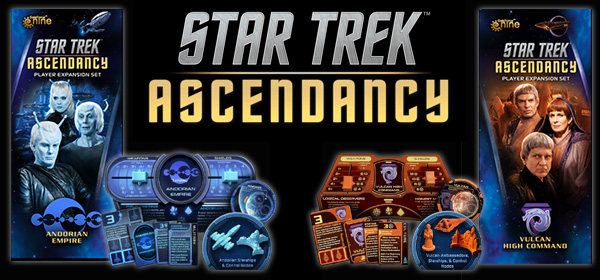
Star Trek: Ascendancy must be a more popular game than I thought. Usually I think of Star Trek games as being pretty niche and unlikely to find widespread success. But Ascendancy must be doing well because 8 years later, Gale Force 9 is still pumping out expansion packs and new accessories. Ascendancy deserves it. It's a fantastic game! In fact, it might very well be my favorite tabletop game at the moment.
The Vulcan and Andorian expansions were both released a few years ago, in 2019. But I couldn't review them near their release because I hadn't had an opportunity to play either of them until this past year or so. That's partly due to the fact that Gale Force 9's distribution isn't the best. The expansions were delayed several times, and my pre-orders were also late arriving. By the time I finally had them both, schedules just weren't favorable for playing. I had an opportunity to play with either faction within a few months of purchasing them, but we ended up sticking with the Ferengi and Cardassians.
We expected to play again soon and break in the Andorian and Vulcan sets, but then COVID happened. Ascendancy wasn't the only victim, as several other games (including Bloodborne, Tapestry, and U-Boot) have also sat un-opened or un-played since the summer of 2019.
Several games (or expansions) have sat un-opened or un-played since 2019 and 2021 thanks to COVID.
Now, GF9 has released another pair of expansions in 2022, with the Dominion War and Breen. This time, I didn't want to wait and risk letting them sit un-played for another 2 or 3 years, so we made sure to find time to play. Though reviews were still very late because I had 4 expansions to play and review instead of just 2. Which means it took quite a few play sessions to play everything and get a decent feel for it all.
It certainly helped that I introduced the game to some new players in the year or 2 following COVID, and they all loved it. I've now played with all the new factions and have impressions on all of them. I'll discuss the Dominion in a separate post, since the Dominion is a lot more complicated than simply being a new faction. It includes new rules for the Bajoran wormhole, Gamma Quadrant systems, and also includes a team variant game mode based on the Dominion War of Deep Space Nine. So for now, I'm going to cover the Andorians, Vulcans, and Breen.
Pre-Federation factions
The pair of 2019 expansions were both themed around Star Trek: Enterprise, offering versions of Federation-member cultures that represent their pre-Federation empires. I have to say, I was very surprised to see these factions be announced. Partly because they are both members of the Federation, and so don't seem like "big enough" galactic powers to warrant their own factions. To me, it seemed comparable to seeing the Virginia Commonwealth or Republic of Texas show up as a playable civilization in Sid Meier's Civilization.
But it was also a confounding release because I was expecting to see the Tholian faction that was promised by the base game's "Crystalline Entity" exploration card. I would have expected to see factions like the Dominion, Tholian, Gorn, or maybe even a Delta Quadrant faction like the Hirogen or Kazon, before seeing the Vulcans and Andorians show up as factions. Nevertheless, both introduce novel new gameplay mechanics and concepts, and show the development team at Gale Force 9 is getting quite creative with its faction concepts. [More]
c8602238-1f38-43f7-b62e-db5a7d8d9a68|0|.0
Tags:Star Trek, Star Trek: Ascendancy, Gale Force Nine, board game, expansion, Vulcan, Andorian, Breen, Dominion, lie, ambassador, research, isolationist
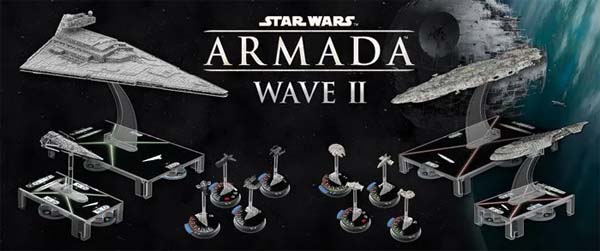
I might have been a bit unfair to X-Wing when I originally reviewed the Star Wars: Armada core set. I gave Armada a pretty glowing recommendation and praised it for giving the player more meaningful decisions and for fixing a handful of complaints that I had with X-Wing. But I kind of neglected the fact that the Armada core set has pretty much the same fundamental problem that stopped me from giving a similarly high grade to X-Wing: the limited content of the package.
X-Wing had three small ships, and a handful of alternate pilots and upgrades to add some replayability. But the game really needed some expansions to really come into its own. And I pointed that out in my review of X-Wing's core set, and docked its final score.
Don't get me wrong, Armada does offer more content in its core set than X-Wing did! It also has three ships, along with alternate ship cards and upgrades. But those three ships are different sizes and strengths, and there's ten fighter squadrons to go along with them. Armada's core set also includes the objective cards that helped to give that game more structured play, while X-Wing only had a couple of scenarios. So I still think that the Armada core set offers more value than the X-Wing core set.
However, I also knew that having a roster of expansion ships would improve the game, and I baked that assumption into my review for Armada. This may have been unfair to X-Wing, especially considering that the Armada core set has other problems that X-Wing doesn't have.
The core learning scenario doesn't do the game justice
It's been difficult for me to get friends into playing Armada. X-Wing has always seemed to be the more popular game. It took me a very long time to finally figure out why. During the past couple years of the COVID pandemic, it hasn't been viable to get together large groups for bigger board games, so I focused more on playing smaller, 2 and 3-player games to limit the number of people over at once. Games like X-Wing and Armada were ideal for that situation. In doing so, I tried a new technique for introducing friends to Armada that would hopefully get them up to speed faster, and which also seems to be much more successful than my earlier teaching attempts using the Learning Scenario.
Put simply: Armada's learning scenario is kind of crap. After teaching friends and co-workers to play the game through the learning scenario, their responses to the game has always been a resounding "meh". I then have to spend thirty minutes or an hour explaining [in vain] the merits of the full game to people who have already lost interest.
The learning scenario takes most of the strategic decisions away from the players.
The problem with the learning scenario is that it puts pre-configured fleets up against each other with no upgrade cards, no objectives, and no obstacles to navigate around. Without upgrades giving ships special abilities that can turn the tide of a game, and without objectives that give the players something to fight over, the early-game decisions of setting the starting queue of commands are really the only significant decisions in the entire game. Unfortunately, the learning scenario takes those decisions away from the players by recommending a default starting queue of commands! Once ships have been pointed at each other and met in the middle of the board, the last 3 or 4 turns of the learning game easily degrade into a passive process of drifting ahead and mindlessly rolling attack dice. Or the players forget to queue up a Navigate command, and the ships fly past each other in round 3, and spend the rest of the match trying to circle back around to get back in firing range.
Sid Meier, the designer of the original Civilization PC game has defined a game as "a series of interesting decisions". By that definition, the learning scenario of Star Wars Armada isn't even a game at all because all of the interesting decisions have already been made by the rule book before the players have taken a single turn. [More]
560a66ce-81de-4e24-8622-af57cd62681e|0|.0
Tags:Star Wars, Star Wars: Armada, Fantasy Flight, board game, miniatures game, expansion, capital ship, squadron, Imperial Raider, Star Destroyer, Interdictor, Home One, hyperspace, hyperdrive
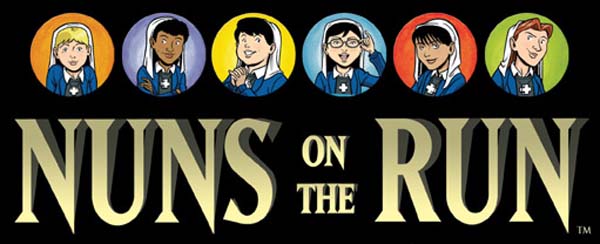
Here is a weird and somewhat unique game that pretty much everybody who I've played with has absolutely loved. More than once, I have had friends over, and we're looking for a not-too-long game to play to kill some time before other players show up for a bigger game. When this happens, after passing up games like Terraforming Mars or Bloodborne: the Card Game or Dominion (all of which are great games), I often just pull out Nuns On the Run and say, "OK, let's try this!". They're always skeptical of the choice, but I say "trust me", and by the time we finish a game, they all want to play again.
Nuns On the Run is a kind of an ideal game for a casual session. It's very quick and easy to set up. The basic rules are pretty easy to explain (even though the rulebook isn't great). It plays pretty quickly and smoothly, with most player action happening simultaneously. And it tears down quickly, making it a great "warm-up" game for a larger game, or as part of a marathon of light or medium-weight games.
Player movements are secret, so their tokens are not moved around the board unless detected by guards.
Secret sin
The theme of Nuns On the Run is that most players play as one of 6 different "novices" (young women in training to become a nun) in an abbey or convent. At night, each novice sneaks out of her bedroom to try to retrieve some secret wish and sneak back to her bedroom before dawn. However, another player (or 2) plays as a pair of adult nun guards, who patrol the convent and try to catch the novices and send them back to their rooms before they fall victim to their sinful desires. The secret desires range from relatively innocent things like a "letter from Mom", to a bottle of laudanum, to more exotic and malevolent things such as a "Book of Dark Magic" (which I always refer to as the Necronomicon).
The gimmick of the game is that all of the novices' moves are secret -- both to each other and to the player(s) playing as the guards. Instead of moving player tokens around the board, novices spend their turn writing their movement action and position on a sheet of paper. The guards, however, are on the board, and they follow pre-defined paths, which are public knowledge to all players. The game has line-of-sight rules, and also rules for novices making noise while they sneak around. If they are ever spotted by a guard, they put their token on the board in the location where they are seen. If they make a noise or disappear from a guard's vision, they place a "vanished" or "sound" token on the board at their last known position.
The secret movement means that all players take their turns simultaneously, so the game moves along swiftly, with hardly any downtime. After committing to their chosen movement, each player checks if their character would have crossed the line of sight of one of the guards, and then rolls a die to determine how much noise they make. The specific movement chosen modifies the die roll, and if the modified roll is less than or equal to the distance from the specific novice to a guard, then the guard hears the novice. Then the guards make their moves and roll a die to determine if they can hear any novices from the guards' new positions.
Secret wishes range from letters from loved ones, to sleeping medicine, to a book of black magic.
The first novice to claim her secret wish and return to her bedroom wins the game. If no novice accomplishes this goal before the end of the 15th turn, the sun comes up, and they are all caught out of bed after curfew, and the guards win. The guards also win if they catch the novices a specified number of times.
The guards are locked into their chosen patrol paths, unless they see or hear a novice in a given turn. However, they don't necessarily have to chase the novice who they spot or hear. Once alerted, the guards can move anywhere to chase or look for novices. Choosing which paths to follow, and where to look for novices when they see or spot something, makes up all of the strategy for the guards. It is best for an experienced player to play as the guards, since knowledge of the board, rules, and locations of keys and secret wishes makes a big difference in how the guards play.
[More]
eb54bfec-a691-4b6a-afb9-5a497e5da333|0|.0
Tags:Nuns on the Run, board game, Mayfair Games, Fréderic Moyersoen, Jared Blando, Jacob Chabot, Catholic, nun, convent, abbey, novice, stealth, blessing
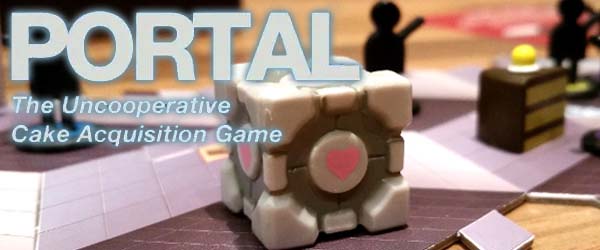
Portal is one of the best and most successful video games ever made. In the current climate of table top board game manufacturers trying to license every property that they can possibly get a hold of, I guess it only makes sense that there would have been a board game based on the Portal video game. But what could a board game designer possibly do with the physics and gravity-bending environmental puzzle-solving concepts of the 2 Portal video games? Cryptozoic's answer was to not even really try. While they did manage to come up with a unique and novel board game design, it's a design that I don't feel really does justice to the title's namesake.
You will be tested, and then there will be cake
Portal: The Uncooperative Cake-Acquisition Game is based around a modular, evolving board concept. 15 tiles are placed on the table in three rows of 5. At the end of each player's turn, one tile is removed from the right edge of the board (the "Old Edge"), flipped over, and moved to the left edge of the board (the "New Edge"). If a player controls a majority of the test subject pieces in the removed tile, he or she is given a set of rewards printed on the tile. This may include being able to place additional test subjects in order to establish more control over the board, being able to place or move a turret or Companion Cube figurine, or placing a victory point token on the board (which takes the form of a plastic slice of cake).
Any player piece(s) on the removed tile are also destroyed. Test subjects are returned to the respective player's supply, but any cake slices (which are victory points) are placed in the "Incinerator", and are removed from the game permanently. The objective of the game, thus, is to place as much cake on the board as you can, while also trying to keep that cake away from the old edge of the board so that it does not become incinerated. What makes this a somewhat challenging puzzle to solve is that the conveyor belt nature of the board is constantly pushing everything towards incineration.
Tiles move from one end of the board to the other, like a conveyor belt.
Each players' test subject tokens can pick up a piece of cake (belonging to any player) and carry the cake with it when the test subject moves. This is how players protect their own cake from the incinerator, but it also allows other players to pick up a rival's cake and move it closer to being incinerated. Thus, the competitive and subversive element is introduced. Players must try to maximize their own resources, while simultaneously trying to minimize their opponents' resources.
Oh, and there's also a couple of portal tokens which allow test subjects to move long distances across the board (and potentially take cake with them). And there's also a GladOS cardboard cutout, which does absolutely nothing except to mark which test chamber tile is being incinerated and recycled. The actual portals in the game's namesake, and the primary villain of the games, thus feel under-utilized. The portals just provide an extra opportunity for long-distance movement, but the game is completely playable without including them at all. They aren't even remotely necessary -- let alone fundamental -- to the board game's design, the way they are in the video game.
Turret and Companion Cube are nice 3-D plastic models,
but GladOS is just a cardboard cutout.
It's also a shame that the GladOS token is not a 3-D plastic model. The turret and Companion Cube are both plastic models and look really nice, so it's a shame that GladOS didn't get the same treatment. If she had, I could easily see this game's pieces becoming part of a nice little display diorama on a shelf somewhere when they are not in use for actual play.
In general, the board game lacks the spatial puzzle-solving element of the video game. The board is constantly in flux, and so a large focus of the game is on manipulating the physical space of the game board, and there is a certain degree of spatial-puzzle-solving present. But from my experience, most of that manipulation feels pretty rote and predictable. While there are certainly the occasional opportunities for really creative plays (especially when ability cards are used to modify various game rules or give the player extra powerful actions), the bulk of the game is pretty straight-forward.
[More]
4d8c2ed3-71aa-4dfa-8725-7de9aa00df1f|0|.0
Tags:Portal, Portal: The Uncooperative Cake Acquisition Game, Portal 2, Cryptozoic, Valve, Steam, GladOS, Cave Johnson, Chell, laboratory, test chamber, cake, turret, Companion Cube, Matt Hyra
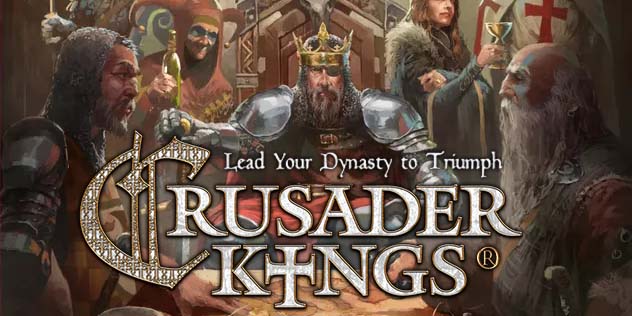
I wasn't very surprised to see a game like Sid Meier's Civilization adapted to a board game. Civ (the computer game) was always heavily inspired by board games to begin it, and so it's mechanics translated easily back into board game formats without losing much other than the broader scope of the PC game.
Paradox's Crusader Kings, on the other hand, is a totally different beast of a PC game. It is an insanely complicated, system-based blend of grand strategy game, RPG, and social sim. It simulates thousands of individual characters across hundreds of countries and duchies through dozens of generations. The possibility space is vast. As such, I would never have expected to see anyone attempt to try to boil down this deep historical simulation into a tabletop board game. Well, I guess I shouldn't say "never". In this age of every media property being adapted to board game formats, I suppose it was inevitable for someone to try.
And someone did try. In 2019, a year before the release of the Crusader Kings III PC game, Swedish board game manufacturer Fria Ligen ("Free League Publishing") released a board game version licensed by Paradox. I received the game as a gift last fall (during the height of social distancing during the COVID-19 pandemic), and so didn't get to start playing the game until well into 2021, when we finally felt a little more comfortable meeting up with friends.
As much a story-generator as a board game
For any PC players coming to the board game, there is something very important that you should know about Crusader Kings: the Board Game: it's focus is largely on the story-telling aspect of the Crusader Kings experience. If you play the Crusader Kings PC game as a hardcore strategy game, then you will probably find the board game lacking in that respect. The Crusader Kings board game is as much a story generator as it is a strategy game -- perhaps moreso.
As a story generator, my friends and I have found Crusader Kings to be very entertaining. It's certainly one of the better story-telling games that I've ever played.
Each action card will include a random event that is either disruptive to the current player,
or which benefits another player.
The way that Crusader Kings creates its little stories is through the random events of each player's action cards, and through the resolution of events by drawing trait tokens. Each turn, a player plays a pre-selected card from their hand. You perform your chosen action, and then you resolve a random event on the card. All cards, except for the "Crusade" action cards, will have a random event that is either harmful to the active player, or which provides a benefit to another player (usually the next player in the turn order).
Many actions and card events will also require that the player draw traits from a bag (similar to a die roll in most other games). Each player character starts with a pre-determined set of traits at the start of the game, and can acquire new traits through marriages, succession, or other events. All your traits go into a bag, and you draw one or more blindly from the bag to resolve a given trait check and determine the outcome of an event.
Player actions, card events, and trait draws, thus combine together to create emergent stories in both the short and long term. Sometimes these little stories can play out over the course of a few actions or turns. Other times, game-long narratives can form. [More]
34573e81-f1df-4d97-b5bc-74233cbd3e71|0|.0
Tags:Crusader Kings, Paradox Interactive, Free League Publishing, emergent narrative, grand strategy, history, medieval, Europe, crusades, war, casus beli, dynasty, succession
|

| 12 | | | | | | | 60 | | 11 | | | | | | | 55 | | 10 | | | | | | | 50 | | 09 | | | | | | | 45 | | 08 | | | | | | | 40 | | 07 | | | | | | | 35 | | 06 | | | | | | | 30 | | 05 | | | | | | | 25 | | 04 | | | | | | | 20 | | 03 | | | | | | | 15 | | 02 | | | | | | | 10 | | 01 | | | | | | | 05 |
|